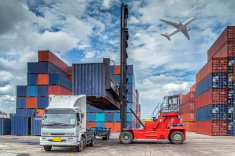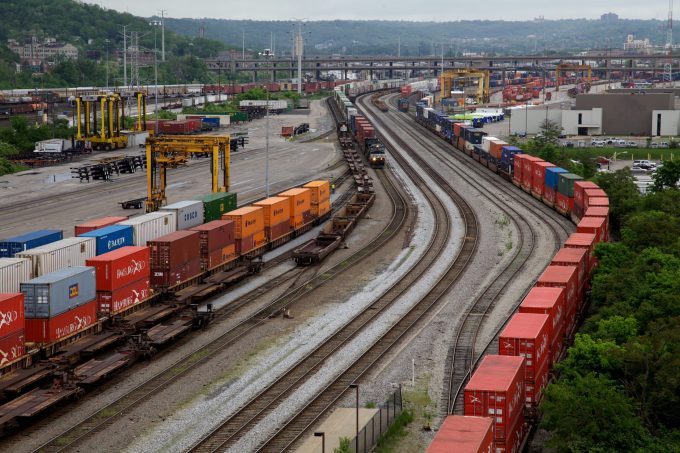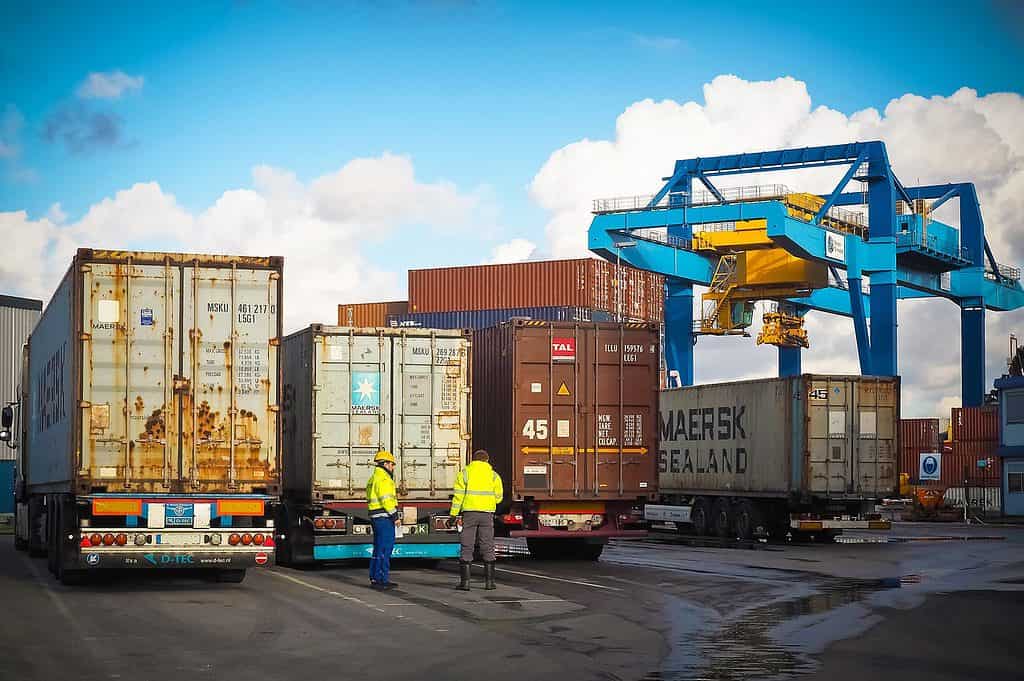Intermodal trucking offers drivers the chance to stay closer to home
Truck drivers who are looking for more local and regional work than their current carrier provide often turn to the intermodal segment of trucking for answers. Many times drivers who are trying out their skills as owner-operators also find a home in intermodal.

But what is intermodal trucking, and what are some of the advantages and disadvantages of driving intermodal?
As the name implies, “intermodal” means that freight-filled containers can be transported by multiple modes of transportation. Containers often arrive in the U.S. by ship, where they can be unloaded and placed on rail cars for movement across the country. Once they are delivered to a rail facility, they are placed on chassis and transported by truck to their final destination. Some containers are trucked directly from the seaport, too.
Since non-trucking modes of transport are often used for longer distances, trucks usually handle the pickup and delivery functions. Some of these are local in nature, with drivers moving several containers in a day’s work. Other moves are more regional, with most containers going to receivers that are within a day’s drive of the port. Depending on the carrier and the availability of work, intermodal drivers often get home multiple times during the week, sometimes daily.
For owner-operators, the equipment requirements for intermodal work can be a little easier to meet than for other segments of the industry. For example, trucks used for intermodal are often older than their over-the-road counterparts. On the West Coast, particularly in California, however, strict emissions-reduction laws have been implemented, all but forcing older equipment out of the business.
Source
The Intermodal system has it’s own problems and logistic issues.
Intermodal Trucking Struggles to be An Alternative Mode for US Container Transport

With the trucking sector losing steam and soaring fuel prices pushing shippers to rein in costs, intermodal traffic should be on the ascent in the US, but the latest numbers show a continuing downward trend.
According to the Intermodal Association of North America (IANA), intermodal volumes dropped 6.6% in the first quarter, year on year. International registered the steepest drop, falling 15.5%, while IANA’s intermodal trailer count was down 12.8%.
The seven intermodal corridors with the highest traffic density, which account for some 60% of all volumes, all showed declines, led by a 15.3% slump in the south-central to the southwest sector.
If margins are slim companies trying to expand need to be creative and sometimes change their business model.
Trucking companies are further expanding into intermodal operations for new avenues for growth.
“What we have seen, probably over the last few years, was market shares shift away from domestic intermodal to truck and international intermodal,” Citigroup analyst Chris Wetherbee told Transport Topics. “I think there’s an expectation for a few reasons that as this year plays out and we go into next year, there is the opportunity for market share to shift back to domestic intermodal, supported by the rails, that will generate growth for all of these companies.”
Wetherbee noted the most important drivers of intermodal growth are supply chains unwinding, fuel costs, and the environment. Environmental, Social, and Governance (ESG) initiatives have become more popular due to customer demand and government regulations that have pushed more carriers to consider ways to be carbon neutral and fuel-efficient.
“You have the expectations that the railroads are going to start getting their operational act together after, let’s face it, over a year of disappointing results,” Cowen and Co. analyst Jason Seidl told TT. “Then, I think, there’s been a big push with companies looking at their own ESG scores.”
J.B. Hunt Transport Services plans to grow its intermodal fleet by 40% to as many as 150,000 containers in the next three to five years as part of a joint effort with BNSF Railway Co. Schneider National on Jan. 19 announced plans to expand its intermodal service by moving its primary Western rail partnership to Union Pacific Railroad.
“It’s clear that intermodal is an important growth engine, both for the railroads and as a method of how the shippers want to move their freight,” Bank of America analyst Ken Hoexter told TT. “And so, the carriers are trying to get improved service and improve fluidity in their network.”
Intermodal Trucking: The Gateway to Versatile and Efficient Freight Transport
Intermodal trucking has emerged as a game-changer in the freight transport industry, offering a seamless and efficient way to move goods across vast distances. Combining the strengths of different modes of transportation, intermodal trucking provides a versatile and cost-effective solution for businesses seeking reliable and timely deliveries. In this blog, we’ll explore the world of intermodal trucking, its benefits, challenges, and how it can be the perfect fit for freight transport in the modern era.
Advantages of Intermodal Trucking
- Cost-Effective: Intermodal trucking optimizes transportation costs by leveraging the most efficient modes of transport for different segments of the journey. This cost-effectiveness translates to significant savings for businesses.
- Environmentally Friendly: By incorporating trains and ships for part of the journey, intermodal trucking reduces carbon emissions and helps businesses meet sustainability goals.
- Faster Deliveries: The seamless transfer of cargo between different modes of transportation ensures faster deliveries, enhancing customer satisfaction and improving supply chain efficiency.
- Reduced Congestion: Utilizing multiple modes of transport helps alleviate road congestion, leading to smoother traffic flow and reduced wear and tear on highways.
Challenges of Intermodal Trucking
- Infrastructure: Intermodal trucking relies on well-developed and efficient transportation infrastructure, including rail yards, intermodal terminals, and ports. In some regions, inadequate infrastructure can be a challenge.
- Coordination: Coordinating the movement of goods between different modes of transport requires precise planning and communication. Delays or miscommunication can disrupt the supply chain.
- Container Compatibility: Ensuring that containers are compatible with multiple modes of transport can be a logistical challenge, requiring standardization across the industry.
Is Intermodal Trucking Right For You?
a) Long-Distance Hauls: Intermodal trucking is particularly well-suited for long-distance hauls, where the combination of trucks, trains, and ships offers an efficient and cost-effective solution.
b) Sustainable Goals: If your business aims to reduce its carbon footprint and improve its environmental impact, intermodal trucking aligns perfectly with sustainability objectives.
c) Time-Sensitive Cargo: For time-sensitive cargo that requires quick deliveries, the expedited process of intermodal trucking ensures timely transportation.
Intermodal trucking presents a compelling option for businesses seeking efficient, cost-effective, and environmentally friendly freight transport solutions. By combining the strengths of trucks, trains, and ships, intermodal trucking streamlines the movement of goods across vast distances, offering faster deliveries and reduced transportation costs. While challenges such as infrastructure and coordination exist, the benefits of intermodal trucking make it an attractive choice for long-distance hauls and businesses striving for sustainability. Embrace the versatility and efficiency of intermodal trucking to power up your freight transport and unlock new possibilities for success in the modern logistics landscape.










